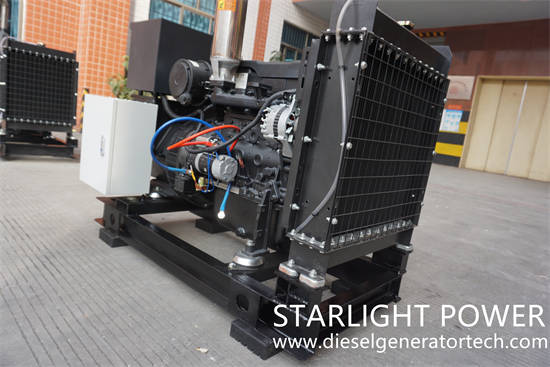Cleaning is an important part of the maintenance of diesel generator sets. The cleaning method and cleaning quality have an important impact on the accuracy, maintenance quality, maintenance cost and service life of the identification unit parts. The cleaning of diesel engine parts includes degreasing, descaling, carbon removal, and rust removal. And old paint etc. Disassembling and cleaning diesel generator set parts also need to pay attention to steps and technology. In this article, Jiangsu Starlight Electricity Equipments Co.,Ltd. will introduce you to the effective cleaning method of diesel generator set parts.
I. Cleaning before disassembly.
The cleaning before the disintegration of the diesel generator set mainly refers to the external cleaning. The purpose of external cleaning is to remove a large amount of dust, oil sand and other dirt accumulated outside the machinery and equipment, so as to facilitate disassembly, and prevent dirt, oil sludge and other dirt from being brought into the maintenance site. Generally use tap water for external cleaning, that is, use a hose to connect tap water to the cleaning part, rinse the oil with water, and use a thick layer of scraper to cooperate, high-pressure water flow, that is, use 1-10mpa high-pressure water flow. For thick scales with higher density, a proper amount of chemical cleaning agent can be added to increase the injection pressure and water temperature.
II. Cleaning after disassembly.
All parts in contact with various oils should be cleaned after disassembly. Oils can be divided into two categories: saponifiable oils, which can react with strong bases to produce soap, such as animal oils and vegetable oils, and unsaponifiable oils, which cannot work with strong bases, such as various mineral oils, lubricating oils, petroleum jelly, paraffin, etc. . They are insoluble in water but soluble in organic solvents. These oils are mainly removed by chemical and electrochemical methods. Commonly used cleaning fluids include organic solvents, alkaline solutions and chemical cleaning fluids, as well as manual and mechanical cleaning methods.
1. Cleaning fluid.
(1) Organic solvents. Common organic solvents are kerosene, light diesel, gasoline, alcohol and trichloroethylene. Organic solvent degreasing is based on dissolving dirt. It has no damage to metals, can dissolve all kinds of grease, does not need to be heated, is easy to use, and has a good cleaning effect. However, most organic solvents are flammable and costly, and are mainly suitable for small units and scattered maintenance work.
(2) Alkaline solvent. Refers to aqueous solutions of alkalis or alkaline salts. The alkaline solution reacts with the saponifiable oil on the surface of the part to produce soap that is soluble in water and glycerin that is not easy to float on the surface of the part. Then it is washed with hot water to easily remove the oil. When the unsaponified oil and saponified oil are not easy to remove, an emulsifier should be added to the cleaning solution to separate the emulsified oil from the surface of the part. Commonly used emulsifiers include soap, water glass (sodium silicate), gum, etc. Different cleaning fluids are used to clean parts of different materials. Alkaline solutions corrode metals to varying degrees, especially aluminum. When cleaning with alkaline solution, it generally needs to be heated to 80°C-90°C, rinse with hot water after deoiling, to remove residual lye on the surface and prevent parts from corroding. Alkaline solution cleaning is widely used.
(3) Chemical cleaning fluid. Refers to a chemically synthesized water-based metal cleaning agent based on surfactants. As the interfacial tension decreases, the interfacial tension decreases and wetting, penetration, emulsification and dispersion occur. It has strong decontamination ability, non-toxic, non-corrosive, non-flammable, non-explosive, and non-polluting. It has the advantages of certain anti-rust ability and low cost.

2. Cleaning method.
(1) Scrub. Clean the parts in a container with diesel, kerosene or other cleaning agents, and wipe them with cotton yarn. The method is simple in operation and simple in equipment, but low in efficiency, and is suitable for a small batch of small and medium-sized parts. Generally speaking, gasoline is not suitable for use because of its fat-soluble properties, which can cause harm to people and easily catch fire.
(2) Boil and wash. Weld the prepared solution and cleaned parts together with the steel plate to the appropriate size, put them in the cleaning pool, and set up a heating furnace at the bottom of the pool, partially heated to 80°C, and can be cleaned at 90°C.
(3) Spray washing. Spray a certain pressure and temperature of cleaning liquid on the surface of the parts to eliminate oil stains. This method has good cleaning effects and high efficiency, but the equipment is complex, and it is suitable for parts with less complex shapes.
(4) Vibration cleaning. Place the cleaned parts in the cleaning basket or rack of the vibrating washer. Immerse in the cleaning fluid, simulate the manual flushing effect through the vibration of the cleaning machine, and combine the chemical action of the liquid with the cleaning to achieve the purpose of eliminating oil stains.
Ultrasonic cleaning depends on the chemical action of the cleaning liquid and the introduction of ultrasonic vibration into the cleaning liquid. The purpose of removing oil stains from parts can be achieved by combining with each other.
Jiangsu Starlight Electricity Equipments Co.,Ltd. is one of the earliest manufacturers of generators and diesel generator sets in China. The company was established in 1974 and the company occupies an area. With an area of 86,000 square meters and a building area of 45,000 square meters, it has 64 sales and service departments across the country to provide users with one-stop service of design, supply, debugging and maintenance at any time. Welcome customers to come to consult and visit. Looking forward to your inquiry, please send email to us for details [email protected]
Copyright © Guangxi Dingbo Generator Set Manufacturing Co., Ltd. All Rights Reserved | Sitemap
Update cookies preferences